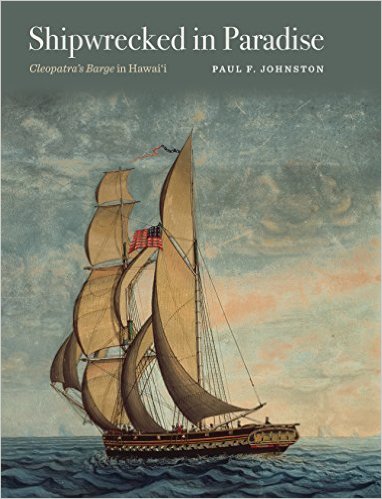Shipwrecked In Paradise: Cleopatra’s Barge in Hawai’i
Paul F. Johnston
 Cleopatra’s Barge was one of the more historically significant ships in American maritime history. Built in 1816, it was the first private seagoing yacht built in North America. In its day, it attracted the type of crowds associated with celebrities when it docked.
Cleopatra’s Barge was one of the more historically significant ships in American maritime history. Built in 1816, it was the first private seagoing yacht built in North America. In its day, it attracted the type of crowds associated with celebrities when it docked.
Shipwrecked In Paradise: Cleopatra’s Barge in Hawai’i, by Paul F. Johnston, tells both the story of the ship and of its recovery by marine archaeologists.
The ship was built for George Crowninshield, Jr., an eccentric Salem, Massachusetts shipping magnate who made a fortune privateering in the War of 1812. He spent some of the money gained during that war to build the then-last word in yachts. He spent a fortune building and outfitting Cleopatra’s Barge, a hermaphrodite brig intended for trans-Atlantic voyaging. He planned many visits to Europe, but died after the first, a trip to the Mediterranean (where he failed to find an Italian princess to wed).
The heir, his brother, sold the ship to King Liholiho of Hawai’i for 8000 piculs (one million pounds) of sandalwood. It remained the Royal Hawaiian Yacht until 1824, when it wrecked in Hanalei Bay in Kaua’i Island (Liholiho was away on a trip to England). The partially-salvaged wreck eventually settled in the bay’s bottom. Paul Johnston, the curator of maritime history at the Smithsonian Institution, was fascinated by this story. Given an opportunity to examine Cleopatra’s Barge, he took it.
The first section of the book describes Johnston’s adventures excavating the ship. It provides an inside look at marine archeology. He includes descriptions of the dives, and the less expected (or desired) aspects. Johnston’s description of his quest to obtain excavation permits is amusing reading, but rivalled the travails of Odysseus.
He then explores the history of the ship itself, telling of its original and subsequent owners, the society in which the ship existed, and the ship’s travels. Johnston provides an entertaining and informative tale. For those interested in maritime history of the early 1800s, this chapter makes the book worth reading.
The next section examines Cleopatra’s Barge’s structure and equipment. It describes the ship’s appearance, including comparing Johnston’s findings to previous assumptions about the ship. Johnston discusses the materials used to build Cleopatra’s Barge, and develops a probable interior arrangement of the ship. It also covers shipbuilding techniques contemporary to Cleopatra’s Barge’s construction.
This is followed with a chapter about what was found during the excavation, both modern and nineteenth century. Part of the challenge in an archaeological study is determining what belongs with the wreck studied, and what just drifted into the site. The contemporaneous artifacts aboard the wreck reveal much about life at that time.
Shipwrecked in Paradise reads like a cross between a travelogue, a history book, and marine archaeology report. It covers its topic with a thorough completeness, yet is entertaining as well. The illustrations are both attractive and informative. Those interested in ships of the period will find this a worthwhile acquisition. The general reader with find it an entertaining read.
- College Station: Texas A&M University Press, 2015
- 8-3/4” x 11-1/4”, hardcover, x + 204 pages
- Illustrations, drawings, diagrams, notes, bibliography, index. $39.95
- ISBN: 9781623492830
Reviewed by Mark N. Lardas, League City, Texas
